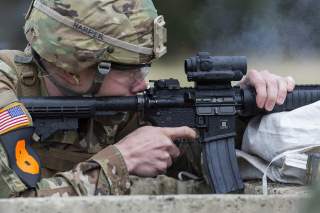Firefight Fail: How the U.S. Army's M-4 Rifle Overheated and Jammed in a Bloody Battle
In the early morning hours of July 13, 2008, a Taliban force of between 100 and 200 fighters attacked an American Forward Operating Base guarded by 48 soldiers of 2nd Platoon, Chosen Company—part of 2nd Battalion, 503rd Infantry Regiment.
Is the M-4 good enough? For now, it has to be.
The U.S. Army’s standard infantry weapon repeatedly overheated and jammed during a bloody 2008 battle in Afghanistan. The Washington Times reported last week on the reported failure of the M-4 carbine during the fierce firefight in Wanat, during which the Taliban nearly overran an Army outpost.
(This first appeared several years ago.)
A direct descendant of the Vietnam War-era M-16, the more compact M-4 is the Army’s standard-issue weapon. The ground combat branch has half a million of the semi-automatic weapons in service and has signed contracts for 120,000 more.
The Army and manufacturers are improving the M-4 to reflect battlefield lessons, but it’s unclear whether these upgrades will prevent another near-catastrophe like occurred at Wanat.
In the early morning hours of July 13, 2008, a Taliban force of between 100 and 200 fighters attacked an American Forward Operating Base guarded by 48 soldiers of 2nd Platoon, Chosen Company—part of 2nd Battalion, 503rd Infantry Regiment.
The paratroopers had just arrived in the area five days prior. The Taliban had been watching—and attacked before the platoon could finish setting up its defenses, which typically include walls, razor wire and machine guns.
Firing machine guns, rocket-propelled grenades and mortars, the Taliban swarmed the American position. The U.S. soldiers called in Apache attack helicopters, 155-militmeter howitzers and even a B-1 heavy bomber to pound the attackers.
The Americans held their ground. But nine soldiers died and 27 suffered wounds. Around 50 Taliban died and evidence suggests 40 were wounded.
What went wrong?
In stand-up fights like Wanat, whichever side is able to generate fire superiority—in other words, throw out more lead—has the advantage. This is particularly important for the defenders, as sheer firepower can slow the attackers’ advance until help arrives.
The paratroopers had brought to the outpost two heavy machine guns, two automatic grenade launchers and an anti-tank missile. These were supposed to be the linchpins of Wanat’s defenses, but accurate Taliban fire disabled most of these heavier weapons early in the battle.
Fire superiority fell to the M-4s. In the Army’s report on Wanat, one soldier described alternating between three M-4s, using each until it jammed.
“My weapon was overheating,” another soldier said. “I had shot about 12 magazines by this point already and it had only been about half an hour or so into the fight.” In other words, the soldier fired approximately 360 rounds in 30 minutes. That’s 14 rounds a minute—one every four seconds.
Guns generate heat with every bullet they fire. Excessive temperatures can result in malfunctions. The officially recommended rate of fire for an M-4 is 12 to 15 rounds per minute. Beyond that, bullets might cook-off and metal components might warp.
At first glance, 14 rounds a minute might not sound like a lot. But the recommended rate of fire for the M-4 assumes regular intervals between shots, giving the weapon a chance to cool in-between. That’s not always possible in combat.
Overheating is in part a consequence of the M-4’s design, which recycles hot gases from each shot back into the rifle to load the next bullet. The gases can heat the rifle until it’s too hot to touch.
Other design issues played a role. The M-4 carbine accommodates the M-203 grenade launcher under the barrel. Fitting a launcher requires a lighter barrel in order to maintain balance—and a lighter barrel heats more quickly than a heavier one. Not every soldier carries an M-203, but in the interest of streamlining logistics, all M-4s have the thinner barrel.
Soldiers have also complained of aluminum magazines that become dented in the field, resulting in stoppages during rapid firing. The M-4 seems particularly sensitive to dirt and sand. The direct impingement system probably exacerbates the dirt problem.
The Army was aware of these issues before Wanat. In 2001, Special Operations Command reported that the M-4 would probably fail after sustained rapid fire. A 2002 internal report by the Army’s Picatinny Arsenal said pretty much the same thing.
Prior to Wanat, overheating was rarely a problem for the M-4. Owing to America’s overwhelming superiority over most foes, battles—although not wars—usually go the way the Pentagon intends.
Wanat was an exception. Second platoon lacked firepower and mobility and the Taliban outnumbered the Americans four to one. Pressed into service as the outpost’s primary defensive weapons, the M-4s simply couldn’t keep up.
“Enemy action and weapons dispositions forced the defenders … to use their M-4s in uncharacteristic roles,” the Army explained in its official history of Wanat. “This, not weapons maintenance deficiencies or inherent weaknesses in weapons design, was the reason a number of weapons jammed during the battle.”
Pushback
The Center for Naval Analyses conducted a small-arms survey and reported high marks for the M-4. Eighty-nine percent of the 817 soldiers who had used the M-4 in combat said they were satisfied with the weapon. Among those who reported dissatisfaction with the weapon, heat was not an issue.
Of those soldiers who reported jams in firefights, 82 percent said they were able to quickly clear the jam. More than half said their M-4s never jammed in combat.
The troops like the M-4 and trust it. And yet Wanat clearly demonstrates that under certain conditions, the weapon can fail—and catastrophically.
It’s rare for the M-4 to overheat in combat. Still, the Army has begun issuing an updated version of the carbine, the M-4A1. The A1 has a thicker barrel and steel or polymer magazines to replace the unreliable aluminum ones.
But the Army cancelled the most urgent upgrade—switching the M-4 to a gas-piston operating system. Gas pistons run cooler under sustained fire than the existing direct impingement. They’re also cleaner.
In the years since Wanat, the Army has repeatedly tried and failed to acquire a brand-new rifle to totally replace the M-4. All of the candidates were more reliable than the M-4 and, not coincidentally, use gas pistons. Every time the Army went shopping for a fresh carbine, it ultimately decided that the new weapons’ improvements weren’t worth the cost.
The soldiers who fought at Wanat might disagree.
The Army is in a difficult position. It has half a million M-4s with an 80-percent satisfaction rate among the troops. It’s a flawed weapon, to be sure, but the worst problems manifest only in rare instances.
Pitched battles are less likely as the Army winds down the war in Afghanistan—meaning the ground combat branch in less likely to fix the M-4’s problems. Then there are the budget cuts—although, to be fair, the Army could upgrade all its carbine for less than the cost of two Air Force F-35 stealth fighters.
Is the M-4 good enough? For now, it has to be.
This first appeared in WarIsBoring here.


